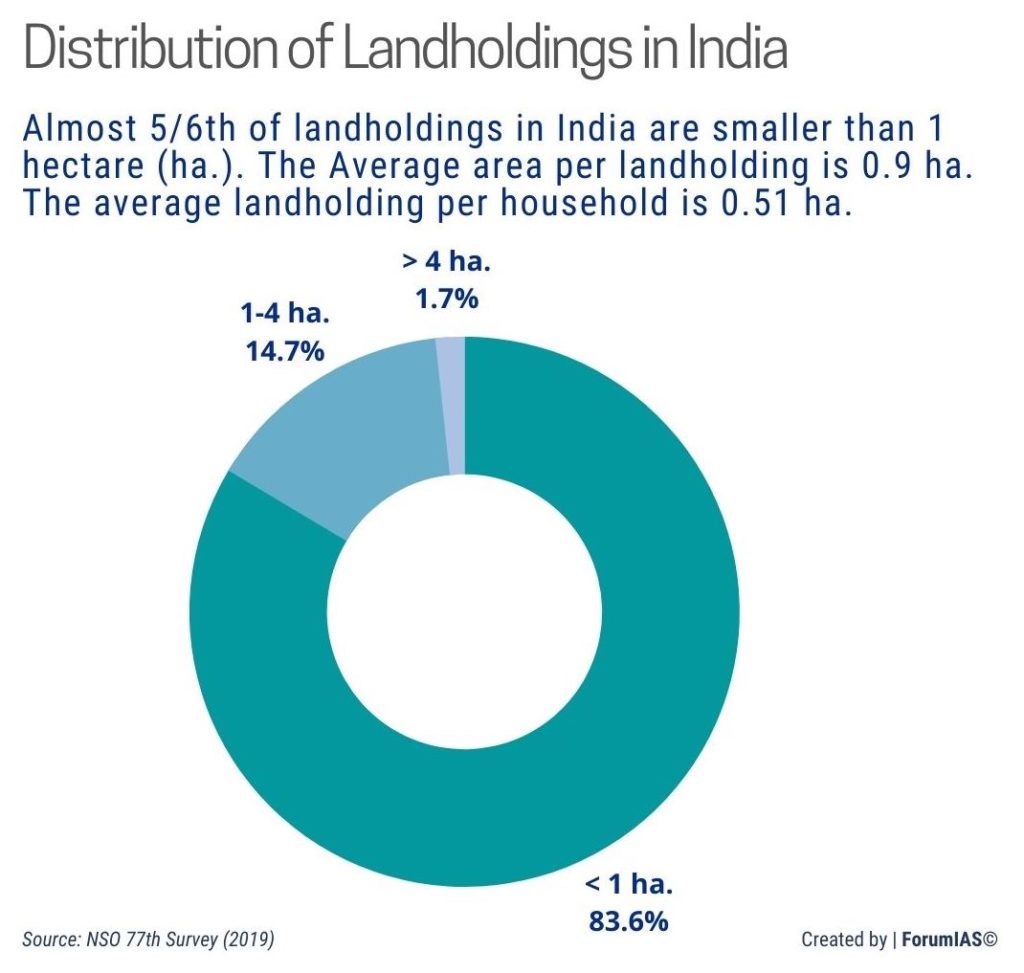ForumIAS announcing GS Foundation Program for UPSC CSE 2025-26 from 19 April. Click Here for more information.
ForumIAS Answer Writing Focus Group (AWFG) for Mains 2024 commencing from 24th June 2024. The Entrance Test for the program will be held on 28th April 2024 at 9 AM. To know more about the program visit: https://forumias.com/blog/awfg2024
| For 7PM Editorial Archives click HERE → |
India’s agriculture exports have grown by 16.5% in April-September 2022 (on a year-on-year basis) compared to April-September in 2021.
Indian agricultural, horticultural and processed foods are exported to more than 100 countries in the world.
Major destination of India agricultural products are USA, Saudi Arabia, Iran, Nepal, and Bangladesh
Major commodities in export basket include rice (both Basmati and non-basmati), marine products, sugar, spices, cotton, wheat and buffalo meat.
Agricultural Exports: Trends
India has been a net exporter of agriculture products (exports greater than imports).
India’s agricultural exports (including marine and plantation products) crossed US$ 50 billion during the fiscal year ended March 31, 2022.
Technological advancements, government incentives, and institutional changes have contributed to a massive increase in agricultural output.
Source: Indian Express
Agriculture Exports: Potential and Opportunities
- India’s large extent of arable land, complemented by diverse agro-ecological conditions provide huge potential for cultivation of agriculture products.
- According to the FAO, India is the largest producer of milk, pulses and jute, and ranks as the second largest producer of rice, wheat, sugarcane, groundnut, vegetables, fruit and cotton. India is also one of the leading producers of spices, fish, poultry, livestock and plantation crops.
- Globally, India ranks second in total agricultural production at US$ 367 billion, yet India’s share in export market is minuscule. This indicates huge opportunity in scaling up the exports.
- Effective action at multiple levels, from farm inputs, quality assurance, traceability and certification, to building connections to global value chains (GVCs) can help India reach the US$ 100 billion milestone in agri-food exports.
- Government renewed focus through policies such as doubling of farmers’ income program; agriculture export policy; ease of FDI in the agriculture sector have increased investors confidence.
- Rise in foreign investments promoting agripreneurship. 100% FDI in agriculture sector is allowed in horticulture, floriculture, apiculture, animal husbandry and aquaculture.
Agriculture Exports: Benefits
- Largest sources of livelihood: Agriculture employs 152 million Indians as of March, 2022. 70% of rural households still depend primarily on agriculture for their livelihood.
- Increase Farmers Income: Increase in export of agri-commodities at globally competitive prices will help increase income for farmers.
- Rural Development: Improvement in farm incomes will boost rural demand and contribute to growth of rural economy and development.
- Trade Balance: Agriculture exports have consistently outperformed agri-imports. Agriculture sector has regularly maintained a trade surplus. This helps in mitigating Current Account Deficit (CAD) and help enhance forex reserves.
Agriculture Exports: Challenges
- Inward-looking policies: India’s agriculture policy is focused more on food security and price stabilization to control inflation in domestic market. The policy deprives farmers of higher prices in the international market.
- Value Addition: Lack of branding and promotion is hurting the competitiveness of India’s agriculture exports.
- Lack of uniformity: Lack of uniform quality standards, standardization of commodities and high losses in value chain have limited the potential of export of horticulture produce.
- Trade and Non-trade barriers: Maximum Residue Limit (MRL) in India’s agricultural products breach phytosanitary and sanitary measures in the global market.
- Low Yield: The yield levels of the majority of crops in India remain much lower than the global average.
- Fragmented landholdings: The average farm size in India is only 1.15 hectares. Majority of the Indian farmers belongs to small and marginal category.
Agriculture Exports: Steps taken
Agriculture Export Policy 2018 (AEP):
- Diversify export basket and destinations.
- Boost high value-added agricultural exports.
- Promote indigenous, organic, traditional and non-traditional Agri products exports.
- Provide an institutional mechanism for pursuing market access.
- Enable farmers to get benefit of export opportunities in overseas market.
Cluster Development:
- As part of the Agriculture Export Policy, 46 unique product-district clusters have been identified for export promotion. 2
- 9 Cluster Level Committees have been formed in different clusters like Varanasi (Fresh Vegetables), Ananthpur (Banana), Nagpur (Orange), Lucknow (Mango).
Financial Assistance Scheme (FAS):
- It is the export promotion scheme by the Agriculture and Processed Food Products Export Development Authority (APEDA).
- The primary aim of this scheme is to assist businesses in export infrastructure development, quality development and market development.
- The financial assistance under the scheme will range from INR 5 lakh (US$ 6,500) to INR 5 crore (US$ 650,000).
Ministry of Commerce & Industry Schemes:
- The Ministry of Commerce & Industry has also initiated several schemes to promote exports, including Trade Infrastructure for Export Scheme (TIES), Market Access Initiatives (MAI) Scheme.
- The Ministry has also collaborated with the Ministry of Civil Aviation and the Railways (and 5 other Ministries) in utilization of Krishi Udan and Krishi Rail respectively, to ease out pressure of high freight rates.
- The effort resulted in smooth movement of perishables to the important Middle East, EU and South East Asian markets.
Agriculture and Processed Food Products Export Development Authority (APEDA):
- It was formed in 1986, under the APEDA Act 1985 for the development of the exports of the agriculture sector in India.
- The main functions of the authority are the registration of people as exporters, fixing standards and specifications for the scheduled products, carrying out inspections, collecting statistics and providing information, training and advisory services to the exporters.
Farmer Connect Portal:
- A Farmer Connect Portal has been set up on APEDA’s website for providing a platform for FPOs/FPCs, cooperatives to interact with exporters.
- Around 2360 FPO/FPCs and 2324 exporters have been registered as of 2022.
Virtual Buyer Seller Meets (V-BSM):
- To promote geographical indications (GI) registered with agricultural and processed food products in India.
- 17 V-BSMs have been organised with countries like Canada, Germany, Switzerland, Belgium, UAE and USA.
Agri-Cells:
- The Government has set up 13 Agri-Cells in Indian embassies in Vietnam, USA, Bangladesh, Nepal, UAE, Iran, Saudi Arabia, Malaysia, Indonesia, Singapore, China, Japan and Argentina.
- Aim is to provide inputs on real time basis to improve Indian exports at these destinations by promoting trade, tourism, technology and investment goals.
Agriculture Exports: A way ahead
- Empowering the farmer to improve quality: Farmers should be trained about export standards and compliances. Krishi Vigyan Kendras can be engaged to take export-oriented technology to farmers and creating awareness among farmers about export opportunities.
- Infrastructure status: Providing Infrastructure status to agricultural value chains, such as warehousing, pack-houses, ripening chambers, and cold storage.
- Branding produce from Export Clusters: Export clusters (like Nagpur for Orange) lack organised marketing and branding support for their products. Branding will help ease their entry into international retail chains.
- Promoting Niche Indian products: Traditional wisdom and nutritional value of niche Indian food products, such as Indian variants of millets, fruits, rice, and oilseeds make them excellent export choices.
- Connect to GVCs: There is a need to connect Farmer Producer Organisations (FPOs) with global value chains and importers from other markets. It can help them understand quality needs and the importers can be assured of quality standards.
- Addressing logistics glitches: Agricultural commodities are perishable; and so logistics must be robust, containers made available timely, and freight costs stabilised.
- Bilateral trade and sectoral agreements: To ensure favourable tariffs for India’s agriculture exports and to address the non-tariff barriers that Indian exports face like the quality and testing protocols, fair trade certifications etc.
- Research and Development: It is important to promote R & D activities for new product development for upcoming markets, like fortification of food products.
Enhancing agriculture exports is one of the most potent lever in improving farm incomes and ensuring rural development.
Source: Indian Express, Indian Express, Indian Express, The Hindu BusinessLine, NABARD






